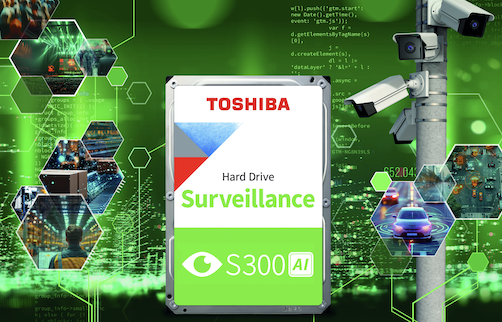The new high-performance, high-capacity hard drive has been specially developed to meet the requirements of modern AI-supported surveillance systems.
Toshiba Electronics Europe has introduced the S300 AI, a new generation of surveillance HDDs designed specifically for the demands of modern AI-based applications in high-definition video recording, analysis and storage. The S300 AI offers higher capacities as well as improved performance and durability to meet the demands of AI-based surveillance tasks.
The S300 AI is available in capacities from 8 TB[1] to 24 TB and supports continuous recording and storage for AI video analysis servers and storage, centralised surveillance data storage systems, video archiving and recovery infrastructures, and multi-bay RAID (Redundant Array of Independent Disks) configurations. The combination of scalability, speed and endurance makes it an effective solution for storing and processing the vast amounts of video and analytics data generated by AI-enabled surveillance systems.
Optimised performance for AI workloads
The S300 AI is designed to handle the additional direct access demands of AI workloads, ensuring fast retrieval of video data for accurate AI analysis and real-time insights.
High scalability for modern surveillance
The S300 AI supports up to 64 high-resolution camera streams[2] and up to 32 additional AI streams. This allows it to be easily scaled to meet the growing demands of AI-driven surveillance. Its large capacity and optimised design make it ideal for continuous recording in a wide range of commercial and infrastructure sectors, including transport, manufacturing, smart city projects, healthcare and nursing, finance and logistics.
Enterprise-level reliability
With an annual workload of 550 TB[3] and a mean time to failure (MTTF) of up to 2.5 million hours[4], the S300 AI is designed for 24/7 operation in mission-critical environments. In addition, Toshiba offers a 5-year warranty on the hard drives, underscoring their durability and suitability for the most demanding surveillance applications.
‘The surveillance market is evolving rapidly, with AI analytics placing new demands on performance, capacity and reliability,’ said Larry Martinez-Palomo, Vice President and Head of the Storage Products Division at Toshiba Electronics Europe GmbH. ‘With the S300 AI, Toshiba is further expanding its HDD range and adapting it to these requirements – with higher capacities, improved performance and durability specifically designed for AI workloads.’
The S300 AI with 8 TB and 10 TB capacities will be available from this month. The 14 TB, 16 TB, 18 TB, 20 TB, 22 TB and 24 TB capacity models will follow in the first quarter of 2026[5].
For more information on the S300 AI, visit https://www.toshiba-storage.com/de/products/festplatte-s300ai-fuer-ueberwachungssysteme/.
- [1] Capacity definition: Toshiba defines one megabyte (MB) as 1,000,000 bytes, one gigabyte (GB) as 1,000,000,000 bytes and one terabyte (TB) as 1,000,000,000,000 bytes. However, a computer operating system reports storage capacity using powers of two for the definition of 1 GB = 230 = 1,073,741,824 bytes and therefore displays a lower storage capacity. Available storage capacity (including examples of various media files) varies depending on file size, formatting, settings, software and operating system, such as the Microsoft operating system and/or pre-installed software applications or media content. Actual formatted capacity may vary.
- [2] The number of supported surveillance cameras is defined by a performance simulation using high-definition cameras at a rate of 10 Mbit/s. Actual results may vary due to various factors, including the type of cameras installed, the hardware and software capabilities of the system, the video compression technology used, and system variables such as resolution, frames per second, and other settings.
- [3] Workload is a measure of the amount of data over the course of a year and is defined as the amount of data written, read, or checked by commands from the host system.
- [4] MTTF/MTBF (Mean Time to Failure/Mean Time Between Failures) is not a guarantee or estimate of product life, but a statistical value based on the average failure rates of a large number of products and may not accurately reflect actual operation. The actual life of the product may differ from the MTTF/MTBF.
- [5] This sample may differ in its specifications from the production version.


